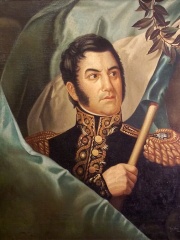
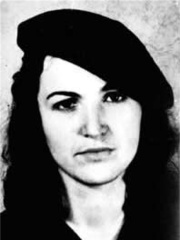
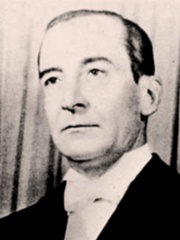
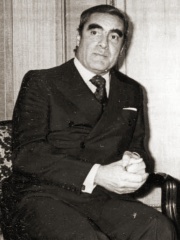
The Most Famous
MILITARY PERSONNELS from Argentina
This page contains a list of the greatest Argentinean Military Personnels. The pantheon dataset contains 2,058 Military Personnels, 5 of which were born in Argentina. This makes Argentina the birth place of the 44th most number of Military Personnels behind Switzerland, and Denmark.
Top 5
The following people are considered by Pantheon to be the most legendary Argentinean Military Personnels of all time. This list of famous Argentinean Military Personnels is sorted by HPI (Historical Popularity Index), a metric that aggregates information on a biography's online popularity.

1. José de San Martín (1778 - 1850)
With an HPI of 75.80, José de San Martín is the most famous Argentinean Military Personnel. His biography has been translated into 80 different languages on wikipedia.
José Francisco de San Martín y Matorras (Spanish pronunciation: [xoˈse ðe sam maɾˈtin] ; 25 February 1778 – 17 August 1850), nicknamed "the Liberator of Argentina, Chile and Peru", was an Argentine general and the primary leader of the southern and central parts of South America's successful struggle for independence from the Spanish Empire who served as the Protector of Peru. Born in Yapeyú, Corrientes, in modern-day Argentina, he left the Viceroyalty of the Río de la Plata at the early age of seven to study in Málaga, Spain. In 1808, after taking part in the Peninsular War against France, San Martín contacted South American supporters of independence from Spain in London. In 1812, he set sail for Buenos Aires and offered his services to the United Provinces of the Río de la Plata, present-day Argentina and other countries. After the Battle of San Lorenzo and time commanding the Army of the North during 1814, he organized a plan to defeat the Spanish forces that menaced the United Provinces from the north, using an alternative path to the Viceroyalty of Peru. This objective first involved the establishment of a new army, the Army of the Andes, in Cuyo Province, Argentina. From there, he led the Crossing of the Andes to Chile, and triumphed at the Battle of Chacabuco and the Battle of Maipú (1818), thus liberating Chile from royalist rule. Then he sailed to attack the Spanish stronghold of Lima, Peru. On 12 July 1821, after seizing partial control of Lima, San Martín was appointed Protector of Peru, and Peruvian independence was officially declared on 28 July. On 26 July 1822, after a closed-door meeting with fellow libertador Simón Bolívar at Guayaquil, Ecuador, Bolívar took over the task of fully liberating Peru. San Martín unexpectedly left the country and resigned the command of his army, excluding himself from politics and the military, and moved to France in 1824. The details of that meeting would be a subject of debate by later historians. San Martín is regarded as a national hero of Argentina, Chile, and Peru, a great military commander, and one of the Liberators of Spanish South America. The Order of the Liberator General San Martín (Orden del Libertador General San Martín), created in his honor, is the highest decoration conferred by the Argentine government.

2. Tamara Bunke (1937 - 1967)
With an HPI of 65.81, Tamara Bunke is the 2nd most famous Argentinean Military Personnel. Her biography has been translated into 27 different languages.
Haydée Tamara Bunke Bider (November 19, 1937 – August 31, 1967) was an Argentine-born East German revolutionary known for her involvement in leftist politics and liberation movements. Born to communist parents, Bunke joined the Free German Youth at fifteen and later studied philosophy at university. She was recruited as an interpreter for the Socialist Unity Party of Germany, where she met Che Guevara during his 1960 visit to Leipzig. In 1961, she moved to Cuba and participated in the Cuban literacy campaign and in the Federation of Cuban Women. Bunke was recruited for the Bolivian Campaign, Che Guevara's guerrilla expedition in Bolivia aimed at sparking revolution across Latin America. Using the alias Tania, she infiltrated Bolivian high society and developed ties with Bolivian President René Barrientos. In 1966, her cover was blown, leading her to join Guevara's armed guerrilla campaign in Bolivia. During this time, she was responsible for the food and monitoring radio communications. Bunke was killed in 1967 during an ambush by Bolivian Army Rangers while attempting to escape with a leg injury and fever.

3. Pedro Eugenio Aramburu (1903 - 1970)
With an HPI of 62.54, Pedro Eugenio Aramburu is the 3rd most famous Argentinean Military Personnel. His biography has been translated into 29 different languages.
Pedro Eugenio Aramburu Silveti (May 21, 1903 – June 1, 1970) was an Argentine Army general and the de facto President of Argentina from 1955 to 1958. He was a major figure behind the Revolución Libertadora, the military coup against Juan Perón in 1955. He was kidnapped by the left-wing organization Montoneros on May 29, 1970, and then murdered as part of retaliation. He had been involved in the June 1956 execution of Army General Juan José Valle—associated with the Peronist movement— and 26 Peronist militants, after a botched attempt to overthrow his regime.

4. Emilio Eduardo Massera (1925 - 2010)
With an HPI of 61.60, Emilio Eduardo Massera is the 4th most famous Argentinean Military Personnel. His biography has been translated into 18 different languages.
Emilio Eduardo Massera (19 October 1925 – 8 November 2010) was an Argentine Naval military officer and a leading participant in the Argentine coup d'état of 1976. In 1981, he was found to be a member of P2 (also known as Propaganda Due), a clandestine Masonic lodge involved in Italy's strategy of tension. Many considered Massera to have masterminded the junta's Dirty War against political opponents, which resulted in over 30,000 deaths and disappearances.
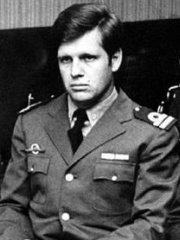
5. Alfredo Astiz (b. 1951)
With an HPI of 58.05, Alfredo Astiz is the 5th most famous Argentinean Military Personnel. His biography has been translated into 16 different languages.
Alfredo Ignacio Astiz (born 8 November 1951) is a convicted war criminal and former Argentine military commander, intelligence officer, and naval commando who served in the Argentine Navy during the military dictatorship of Jorge Rafael Videla during the Proceso de Reorganización Nacional (1976–1983). He was known as El Ángel Rubio de la Muerte (the "Blond Angel of Death"), and had a reputation as a torturer. He was discharged from the military in 1998 after defending his actions in a press interview. He was a member of GT 3.3.2 (Task Group 3.3.2) based in the Naval Mechanics School (ESMA) in Buenos Aires during the Dirty War of 1976–1983. The school was adapted as a secret detention and torture center for political prisoners. As many as 5,000 political prisoners were interrogated, tortured and murdered in the ESMA during those years. GT 3.3.2 was involved in some of the 8,961 deaths and other crimes documented by a national commission after the restoration of democratic government in Argentina in 1983. Astiz, a specialist in the infiltration of human rights organizations, was implicated in the December 1977 kidnapping of twelve human rights activists, including Azucena Villaflor and two other founders of the Mothers of the Plaza de Mayo, and two French nationals, Léonie Duquet and Alice Domon, who were Catholic nuns. None of the twelve were seen alive again outside detention and all were believed killed, rumored to be among the bodies washed up on beaches south of Buenos Aires in late 1977. At the beginning of the 1982 Falklands War, Astiz surrendered with his team to British forces. Sweden and France wanted to question him about "disappearances" of their nationals at his hands but, considering issues of the Geneva Conventions, the United Kingdom had him questioned by a British policeman. Astiz refused to answer any questions. The UK did not think it had grounds to hold or prosecute him, as he was suspected of crimes committed in Argentina that were not then defined as against international law, and repatriated him. In 1986 and 1987, Argentina passed the Pardon Laws, providing a kind of amnesty to military and security officers for crimes committed during the Dirty War. In 1990, a French court convicted Astiz in absentia for the kidnapping of Duquet and Domon, and sentenced him to life imprisonment. After the Argentine Supreme Court's 2005 ruling that the Pardon Laws (Ley de Obediencia Debida and Ley de Punto Final) were unconstitutional, the government re-opened prosecution of war crimes cases. That year Astiz was detained on charges of kidnapping and torture. A mass grave with several unidentified bodies was found in July 2005 in a cemetery about 400 kilometers south of Buenos Aires; forensic DNA testing identified Duquet, Villaflor, and two other founding Mothers of the Plaza de Mayo. The prosecution of charges against Astiz included murder. Together with numerous other defendants associated with ESMA, Astiz was convicted and sentenced to life imprisonment in Argentina for crimes against humanity on 26 October 2011.
People
Pantheon has 5 people classified as Argentinean military personnels born between 1778 and 1951. Of these 5, 1 (20.00%) of them are still alive today. The most famous living Argentinean military personnels include Alfredo Astiz. The most famous deceased Argentinean military personnels include José de San Martín, Tamara Bunke, and Pedro Eugenio Aramburu.
Living Argentinean Military Personnels
Go to all RankingsDeceased Argentinean Military Personnels
Go to all RankingsJosé de San Martín
1778 - 1850
HPI: 75.80
Tamara Bunke
1937 - 1967
HPI: 65.81
Pedro Eugenio Aramburu
1903 - 1970
HPI: 62.54
Emilio Eduardo Massera
1925 - 2010
HPI: 61.60
Overlapping Lives
Which Military Personnels were alive at the same time? This visualization shows the lifespans of the 4 most globally memorable Military Personnels since 1700.

